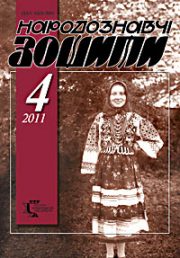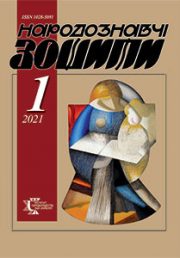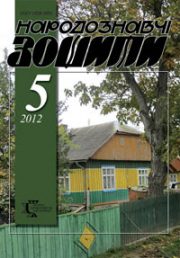The Ethnology Notebooks. 2020. № 1 (151), 15—20
UDK2-135: 2-144.4: 39: 7.016.4
DOI https://doi.org/10.15407/nz2020.01.015
SELIVACHOV Michael
ORCID ID: https://orcid.org/0000-0001-9199-0270
Doctor of Arts (hab), Professor,
Head of the Design and Technology Department
in the Kyiv National Uneversity of Culture and Arts
36, Evgeni Konovalets str., 01133, Kyiv, Ukraine,
Contacts: e-mail: mik_sel@ukr.net
Abstract. The urgency of the topic is that anthropomorphic motifs in the Ukrainian ornamentation are relatively rare and quite often connected with phito- and zoomorphic details. The dictionary of elements and motifs of Ukrainian ornamentation, compiled by the author according to their folk names, has about 1500 nests. Majority belongs to the «sceuomorphic» motifs, associated with man-made realities — more than 200 nests. Almost the same amount falls on the share of plant patterns, and half the number of zoomorphic motifs (about 100). The number of anthropomorphic images, even together with related mythological-folklore images, is slightly more than 60. They are found in all the kinds of art, primarily in Easter Eggs and embroidery.
The subject and the goal of article is to constitute a typology of such a designs, applying the method of juxtaposition graphical variants with their folk nominations. Author singled out eight basic types (having intermediate variants). Most of the anthropomorphic motifs are with obviously female features. The connection with the image of the Great Neolithic goddess is out of question.
The author concluded, that anthropomorphic motifs are filled with multilayer polysemantic meaning: protection from evil forces, magical stimulation of fertility, procreation etc. Folk ornamentation of Ukrainians has preserved many motifs inherited from primitive specimens, especially since the Neolithic period. But there are no nominations directly derived from the characters of pagan mythology, as well as from the names of demonic beings.
The only exception is the name «Bereginya», brought in the art history literature only since the late 1960s. Undoubtedly, «Bereginya» is a late mythology introduced into a wide speech turnover and even in vogue due to the sweetness of this word. In any case, our field research of the 1970s and 90s, the lexeme «Bereginya» as the name of the ornamental motif, has never been recorded. It is absent in publications devoted to folk ornament of the end of the nineteenth and early twentieth century. However, due to some writer-journalists, adherents of the national romantic, since the 1980s the image of the «Bereginya» not only spreads, but also becomes generally understood, generally accepted and generally acceptable. The original negative semantics of the lexeme, as the denomination of the demonic character, was replaced by a positive: a guardian, who protects her native land. This is а сase of transformation folklore notion into «fakelore».
Keywords: anthropomorphism, folk ornament, image, symbol, sign, mythologem, Ukraine, Berehynya, folklore, fakelore.
Received 3.01.2020
REFERENCES
Selivatchov, Michael. (2013). Lexicon of Ukrainian ornamentation (iconography, nomination, styles, typology). Third edition, completed and revised. Kyiv: Ant; Phoenix [in Ukrainian].
Konovalova, O.V. (2010). Anthropomorphic motifs of the 19th—20th centuries Ukrainian folk ornamentation (iconography, symbolic context, artistic features). Abstract… Candidate of Art Studies. Ivano-Frankivsk [in Ukrainian].
Kara-Vasilyeva, T.V. (1983). Poltava folk embroidery (Pp. 191—208). Kyiv: Scientific Thought [in Ukrainian].
Binyashevsky, Erast. (1968). Ukrainian Easter eggs: Album. Kyiv: Art [in Ukrainian].
Onishchuk, Odarka. (1985). Symbolism of the Ukrainian Easter egg. Published by the author. Toronto [in Ukrainian].
Litvinova, P.Ya. (1878). South Russian folk ornament: Issue 1. Chernihiv province. Glukhov county. Patterns of embroidery, cloth and drawing. Kyiv: Typography of M.P. Fritz [in Russian].
Kulzhinsky, S.K. (1899). Description of the folk Easter eggs collection. Issue I. With an album of 33 chromolithographed and 2 black tables, 2219 figures (E.N. Skarzhinska Museum in Lubny. Ethnographic department). Moscow: Skoropechatnya A.A. Lowenson [in Russian].
Lasiychuk, Vasyl. (1986). Written notes about nominated motifs of the Carpathian Easter eggs ornaments [in Ukrainian].
Shcherbakivsky, Vadim (1925). The main elements of the Ukrainian Easter eggs ornamentation and their origin. Studio. Prague: Ukrainian Historical Philol. Society in Prague [in Ukrainian].
Gimbutas, Marija. (1958). Ancient Symbolism in Lithuanian Folk Art. Philadelphia American Folklore Society.
Gimbutas, Marija. (1973). The Gods and Goddesses of old Europe 7000—3500 B.С. Myths, Legends and Cult Images. London.
Gimbutas, Marija. (1989). The Language of the Goddess: Unearthing the Hidden Symbols of Western Civilisation. San Francisco: HARPER & ROW.
Golan, Ariel. (1993). Myth and symbol. Moscow: Russlit [in Russian].
Rybakov, B.A. (1948). Ancient elements in Russian folk art: (Female deity and riders). Soviet ethnography, 1, 90—106 [in Russian].
Rybakov, B.A. (1972). Origin and semantics of rhombic ornament. Museum of Folk Art and Art Crafts (Vol. V). Moscow: Fine Arts [in Russian].
Rybakov, B.A. (1964). The Semantics of the Tripoli Ornament. Abstracts. 1st Symposium on Archeology and Ethnography of the Southwestern USSR (Pp. 11—13). Chisinau [in Russian].
Rybakov, B.A. (1981). Paganism of the ancient Slavics. Moscow: Science [in Russian].
Walker, Barbara. (1988). The Womans Dictionary of Symbols and Sacred Objects. San Francisco: Harper Collins.
Grinchenko, Boris (1907—1909). Dictionary of the Ukrainian Language (Vols. 1—4). Kyiv [in Ukrainian and Russian].
Vasilenko, V.I. (1902). Experience of a folk technical terminology dictionary in Poltava province. Kharkov [in Russian].
Volkov, F.K. (1878). Distinctive features of South Russian folk ornamentation. Proceedings of the 3rd Archaeological Congress in Russia (Vol. 2, pp. 317—325). Kyiv [in Russian].
Kosacheva, O.P. (1876). Ukrainian folk ornament. Embroidery, Fabrics, Easter eggs. Kyiv: S. Kulzhenko [in Russian].
Cordouba, Miron (1899). Easter eggs in the Halician Volyn region. Materials on Ukrainian-Rusian Ethnology (Vol. 1, pp. 169—210). Lviv [in Ukrainian].
Litvinova, P.Ya. (1877). Russian folk patterns. Issue 1. Little Russian patterns of Chernihiv and Poltava provinces. Kyiv: Ed. Kyiv. people. Calendar [in Russian].
Litvinova, P.Ya. (1902). South Russian folk ornament. Chernihiv province (Counties: Konotop, Krolevets, Novgorod-Seversky and Starodub, vol. 2). Kharkov: M. Silberg and Sons [in Russian].
Shukhevych, Volodymyr (1899—1904). Hutsulshchyna (Vol. 1—4). Lviv: Published by the Shevchenko Scientific Society [in Ukrainian].
Donchenko, Vira (1986). Written notes about nominated motifs of the weaving and embroidery ornamentation in the historical Chernihiv region, mainly based on the materials of the Sumy Art Museum [in Ukrainian].






